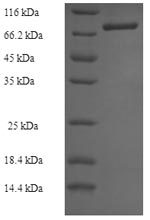Amino acids 37-524 constitute the expression domain of recombinant Human TXNRD2. The expected molecular weight for the TXNRD2 protein is calculated to be 68.9 kDa. This TXNRD2 recombinant protein is manufactured in e.coli. The N-terminal 6xHis-SUMO tag was fused into the coding gene segment of TXNRD2, making it easier to detect and purify the TXNRD2 recombinant protein in the later stages of expression and purification.
The human thioredoxin reductase 2, mitochondrial (TXNRD2) is an enzyme primarily localized in the mitochondria. TXNRD2 plays a crucial role in cellular redox homeostasis by catalyzing the reduction of thioredoxin, a key regulator of cellular redox status. This process is essential for maintaining the proper function of various cellular proteins and protecting cells from oxidative damage. Additionally, TXNRD2 contributes to the regulation of apoptosis and participates in DNA synthesis. Dysregulation of TXNRD2 has been implicated in various diseases, including cancer and neurodegenerative disorders. Research on TXNRD2 focuses on understanding its functions in cellular redox signaling, its role in health and disease, and its potential as a therapeutic target.







